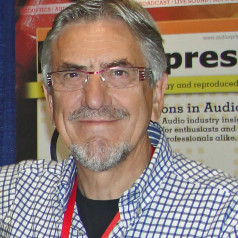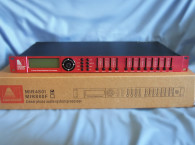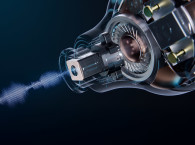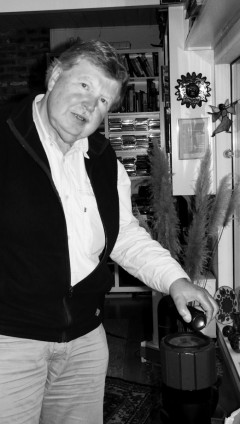
If you are in speaker design, either professionally or as a DIYer, you know Siegfried Linkwitz, period. For decades Mr. Linkwitz has put his mark on speaker and crossover design in audio. Yet, his career was not in speaker design but in microwave test equipment. It is just a coincidence that audio wavelengths are comparable to microwave wavelengths. Or is it? - audioXpress original article - April/2011
Jan Didden (JD): Siegfried, perhaps the first question I should ask is how you got involved with loudspeaker technology in the first place?
Siegfried Linkwitz (SL): Well, it did have a link to my job at HP. We had just brought out a new Fourier analyzer, and KEF in the UK wanted to buy one for their loudspeaker research department.
They sent Laurie Fincham to California to learn about the capability of the equipment and how to use it for their purposes. That exposed me to the speaker research of the time (this was in June 1974) and raised my interest. Then, after the project was done for HP, I sent a (handwritten) letter to Laurie reiterating my findings: the importance of equal rate of phase change with frequency (which, of course, is group delay) for the low- and high-frequency crossover filter outputs, and the importance of correcting for the delay due to driver mounting. All this requires that the drivers be mounted as close together as possible in a vertical line.
My letter also mentioned the new class of Butterworth-derived crossover filters Russ Riley had come up with, which met all requirements and greatly simplified their design. At the time, I also had done some practical tests on the audibility of frequency-dependent group delay introduced by the crossover filters.
Anyway, that letter closed with the following sentence (Fig. 1 ): “That should be the end of my involvement with speaker design and I will just enjoy listening to music and will leave further research to others”—little did I know that I would not be able to let go of it for the coming decades! Now, being retired from HP, I spend even more time on loudspeaker and crossover research and especially the perception side of it.
JD : Before we delve further into speaker technology, can you tell us how you as a German graduate engineer ended up with HP in California?
SL : I started in ham radio when I was 14. I was too young to get a license, so I thought that if I would transmit at 2m using a highly directional Yagi-type antenna, the Post Office people wouldn’t catch me. Now, I didn’t have any test equipment, so to find the right frequency, I strung a couple of wires down the hallway, connected to my transmitter, as a transmission line to set up standing waves. Then I would slide a flashlight bulb across those wires to find the nulls, the dark spot, and measure the wavelength.
I also became interested in audio at the time because my father, who played the piano, had lots of records and liked to listen to music on the radio. I had the Telefunken Laborbuch, which showed this corner speaker, which I built for my father and it worked quite well. So there you have two factors already.
Eventually I decided to study electrical engineering at the Darmstadt Technical University and as part of the curriculum you had to spend periods working in industry. That brought me to Telefunken and Siemens. At the time Telefunken was in the studio business, and I remember listening to their early plasma tweeter, the ionovac. They also had what was called the “Filbertz Transformer,” a toroid power amp output transformer. They figured out a way to wind it so that the stray inductances were way down so it was a really broadband transformer. It was heavily impregnated and packaged to prevent competitors from figuring it out.
Then, in 1960, HP offered a summer job to one EE student from the TU, which my best friend managed to get. My friend wrote such enthusiastic letters about life at Palo Alto and the work at HP that I thought maybe I should go there too for a few years before settling in with Siemens or Telefunken (which was sort of standard OP at the time: you graduated and settled in at one of the big companies for the rest of your life). Now, Barney Oliver, of Oliver amplifier fame, had been doing post-graduate studies at the Darmstadt Technical University just before the war. He was now an important person at HP R&D and still had some contacts with his erstwhile professors. So after graduating I used this contact and wrote Barney to ask him for a job. I didn’t get any answer, so I got a job at the Siemens Central Lab. Then out of the blue I was invited to interview at the new HP outfit near Stuttgart. The interview was largely conducted on paper as I had a hard time understanding English, but you know schematics and equations are the same in any language, and as soon as I understood what they wanted it went quite well.
Then I received another telegram saying that I could start at Palo Alto in four weeks. Now suddenly I was in a big hurry, wanting to get married before going to the US and other personal stuff, but, here I was! I was planning to stay up to two years in the US and then go back to Siemens. At HP I did my first serious work in solid-state technology, although we continued to use tubes, notably the nuvistor, to avoid the temperature drift of the then-used germanium transistors.
After three years in the US I took a leave of absence and went back to Germany. But I was already hooked on the free, open, and flexible work organization in US companies, especially HP.
Also my wife Eike liked the US very much so we decided to return and make our life here. We became involved in politics, in the Vietnam Peace Movement at the time, so we really got ourselves “integrated” as it would be called today. Eventually we became US citizens.
Because of my experience with war in Germany, I had no sympathy for military service and I registered as a “Conscientious Objector,” which was quite an involved process, including a judge hearing that was recorded on a mechanical phono-recorder!
But I must mention that before Laurie Fincham and KEF came to HP, I was already involved in audio. You see, all the young and eager engineers at HP had a hobby that often involved audio. We built all sorts of audio equipment except speakers, which we considered some kind of black art, so we just bought speakers we thought sounded good. We then tried to improve them with things like equalization, finding out quickly that that only gets you so far. So when we came in contact with KEF, that was our chance to find out why they did what they did.
We microwave engineers looked at speakers from a wavelength and antenna pattern background. At the time, most speakers had two or three drivers seemingly randomly mounted on a rectangular baffle. That didn’t make sense to us because we knew that all these driver signals had to add together eventually in front of the listener. So, when we asked them why they used that particular arrangement, the answer was: because it sounds right this way.
Of course, this was not a very satisfying answer for an engineer!
So we said, okay, let’s look at it more systematically and see whether we can come up with some improvements. What also generally wasn’t understood at the time was the interaction of the electrical and the acoustical aspects of the driver, and how the output of multiple drivers added in space. Also, the phase shift that was introduced by the crossover filters used at the time caused changes in the polar response in the crossover region. So what we found was that you might have a polar response directed at the listener for low frequencies, and then at the crossover region it just pointed somewhere in space, and then at higher frequencies it pointed back at the listener again. It didn’t look right to us at all. There were, of course, differences between Butterworth and Bessel and whatever filter types people were using, but they all had similar response problems.

SL : To the best of my recollection, I believe that the importance was not appreciated and so it was not considered. Most filters used were first- or third-order Butterworth, and all passive, of course. The KEF people were aware at the time of the polar response issues resulting from driver offset and were working on a solution involving 2nd order two-way Butterworth filters. We looked at it as engineers and would say: if you have a delay due to driver offset, put in an electrical delay using an allpass filter! And Fincham immediately realized what was going on.
Then Russ and I decided to write it up in a joint paper for the AES because we just didn’t want something of general interest like this to be locked up in a patent. At the end I wrote the AES paper as Russ wasn’t really interested; don’t forget, this was just a hobby for us. Actually, it was Laurie Fincham who eventually coined the term Linkwitz-
Riley filter; internally in HP we called it the Riley-Linkwitz filter.
JD : You mentioned some research on the audibility of varying group delay?
SL : Yes; you see, crossover filters may sum to a flat amplitude response but not the phase response; the phase response is not linear in the crossover region. The derivative of the phase response is not constant, meaning you have a varying group delay. I built some breadboards for KEF to see whether that was audible. It was easy to simulate because you could just feed your speaker through an all-pass filter; you didn’t even need a crossover.
The interesting thing is that the non-constant group delay causes ringing in your signal, even when the frequency response is absolutely flat! So it’s easy to measure and you can hear it with test signals, if it is serious enough, but I’ve never heard it on music. My conclusion at the time was that it isn’t a critical issue in crossover frequencies in the mid band, but it can be on the very low end. All speakers have a high-pass characteristic there and the rate of rolloff determines the group delay peaking you get. And, surprisingly, that is audible; it is the phase nonlinearity, expressed as non-constant group delay that is audible.
JD : Is that the same ringing you see in vented systems?
SL : Well, in vented systems you can also have an amplitude ringing issue. But even with a smooth amplitude behavior, if the rolloff is steep enough you get strong phase nonlinearity, although you’d probably call it energy storage or resonance.
Vented enclosures are a convenient commercial solution to provide more bass. But my approach is that speaker systems must be aperiodic and shouldn’t have storage or resonance behavior. It’s a fundamentally wrong approach for getting natural reproduction. You can get more bass, but it isn’t an accurate reproduction of the electrical input signal.
And again, as engineers we were interested in accurate electroacoustic transducers, adding nothing, taking nothing away. Although, if you leave something out, our perception is very forgiving, much more than when you add something that wasn’t in the original signal.
Generally speaking, today’s components are so good that nonlinear distortion in a speaker is hardly a problem anymore. The real problem with a box loudspeaker is related to energy storage and release. A driver radiates not only in front but also back into the enclosure.
I’ve measured pressure levels inside enclosures with a microphone and they can really be enormous. And all that energy excites the enclosure wall nodal modes. That energy is partly dissipated as heat in the walls but a large proportion is re-radiated either from the outside or from the inside and then comes back out through the cone. That is why all boxed loudspeakers have their own characteristic enclosure sound.
Typically what designers do is stiffen the enclosure pushing the resonances to higher frequencies where they can be better controlled. You see aluminum enclosures which have relatively high resonances in the tweeter frequency area. It’s relatively easy to decouple the tweeter from the front panel so those resonance modes are not excited.
Also, the bracing people use inside enclosures works not only to stiffen the box and drive up the resonance frequency, but it also creates a more turbulent air flow which also helps dissipate the energy. Nobody has really come up yet with an acoustic resistor that you can stick in a box and that turns the acoustic energy into heat. Those so-called variovents are resistive but are not efficient enough to absorb the internal energy.
JD : You could use a transmission line or similar enclosure to “lose” some of the energy.
SL : Yes, that is the solution I used with the Pluto [Siegfried’s design of a small, two-way pipe speaker], which uses the pipe length to attenuate the rear radiation when it goes down to the bottom and comes up again to enter the room through the cone; as you know, a cone is pretty transparent to the reflected wave from the box. When you measure the reflection coming out of the cone, it is about 40dB down from the main signal. And as a microwave engineer you’d say, hey, that’s a pretty good transmission line with 40dB return loss (smiling)!
I did try the stiff box approach myself, and it can work to a certain degree, especially if you can keep the box small because small boxes can be made stiffer with a higher resonance frequency.
I also tried the opposite, a very “limp” box which consisted of an enclosure of thin plywood, and on the inside I put a mixture of sand and tar on the panels. If you knock on such a panel it’s like knocking on your hand; the energy is dissipated and it doesn’t resonate. It does work rather well, but you end up with a very smelly speaker in your living room, and in time the tar mixture runs down into the bottom of the cabinet. Not a promising avenue.
But eventually, after hearing Quad and other ESLs, I concluded that there’s something with those speakers that I can’t get out of my box speakers. People would say, you know, these foils are so light so they are so fast, which is nonsense.
The foil is so light because the electrostatic motor force is so weak, and couldn’t move anything heavier.
There was another key experience for me in those days when I had to build a PA system that was to be connected up to a satellite link between different countries (this was in the days of my involvement with the Peace Movement).
Different speakers (persons, not enclosures) from around the world would hold speeches and we would listen to them in the Santa Rosa sports hall. That hall had lots of speakers that could be very loud but you couldn’t understand a word, which sort of defeated the purpose.
So I built this 8′ column speaker in two 4′ sections which would fit my car, designed as a dipole, reasoning that when somebody was speaking into a mike he/she could be standing next to the speaker but in the radiation null and there wouldn’t be any feedback problems. And it worked superbly! The people close by were not blasted by the high volume, and the intelligibility in that awfully reverberant hall was amazingly good. When it was over I took that speaker home and thought, how would it sound if I used the two sections for stereo in my living room?
And what struck me was how much they reminded me of what I heard from those ESLs. The dipole column was crude, but there was something that motivated me to try to build a real good dipole speaker, and see whether I could move further toward the goal of realistic reproduction than I got with boxed speakers. This was around 1985.
JD : Coming back to those pesky crossovers, didn’t you ever get the idea to play with full-range drivers and see whether you could get rid of the crossover altogether?
SL : Well, that corner speaker I built for my dad was a full-range! But I do not believe that you can build a full-range driver that can satisfactorily reproduce all frequencies at power levels required for a realistic reproduction. It’s just the physics of it that preclude it. Even with a two-way you’re pushing it. In my book, a three-way is required to really get a good, realistically sounding system.
On the other hand, with a four-way you encounter all kinds of problems trying to get those drivers well integrated and balanced, and to get a smooth and even radiation pattern. Complexity goes up fast. In the Orion, which is a three-way system, I added a woofer to share the load but not to extend the frequency response or to make it into a four-way; it still is a three-way system. And still in a three-way you have to carefully select your trade-offs. I would really like an even smaller tweeter for better radiation
pattern at the high end, but then the midrange has to cover higher frequencies.
JD : What are the physical issues with a two-way?
SL : Well, suppose you select a 6- or 8” low/mid driver because it nicely matches your tweeter. Then you calculate the volume displacement from that 8” cone with, say, a maximum linear excursion of 5mm and you find that you need more for the low register. Fine, so we’ll get a 12” driver, but now you get beaming from that woofer by the time you cross it over to the tweeter, which, being relatively small at that frequency, has a broad radiation pattern, and then it begins to beam at higher frequencies.
And most probably the tweeter can’t move enough air at the crossover region to match the rolloff of that 12” woofer.
So you may get a nice flat response on-axis but off-axis it varies all over the place. Now outdoors that would be fine, but as soon as you put this system in a room, the reflections also follow that varying off-axis response and you get coloration in your reflections.
So, coming back to the fullrange, you want to keep it small to let it reproduce the high frequencies, and you want to make it large to pump enough air at low frequencies. An impossible task.
JD : You could build a long column with lots of full-range drivers and electronically equalize it.
SL : Yes, it is possible. But, in a room, you would need to build that line source from floor to ceiling to avoid lobing from the ends. Don Keele has done some very interesting work in that area. For large spaces it is a good solution but for home applications it is not necessary to go that way, and I don’t believe it is necessarily a qualitatively good solution.
JD : Did you at the time use that “Barney Oliver” amplifier for your system?
SL : Oh, yes, it was quite famous at the time. They actually had a small production run at HP and field sales people who performed well got one as a kind of reward! Barney was quite a character. He was one of the people who got the SETI project off the ground. He was always our last resort when we had technical problems or didn’t understand what was going on. We would ask Barney and somehow he always got us moving again.
Every year we would have a division review when top brass like Dave Packard and Bill Hewlett and Barney and finance guys would visit the division. They would talk with us about our products, how many we thought we would sell at what price, and they would play with the equipment and ask questions. Barney was always critical and some people were nervous when he was around.
JD : I’ve been reading some of the recently published books about HP, one written by Dave Packard himself, and what struck me was the novel way the company was focused not only on products but also on employees and organizational matters. One memo from the early days I’ve read said that “the organization of the company was discussed, and the question of what to produce was left for the next meeting,” which seems the wrong way around!
SL : It was so totally different to what I was used to in Germany. At HP you could just go for lunch in the cafeteria and find Bill Hewlett taking a seat next to you and chat with you. Their offices had the same cubicle format, with room dividers, as we all had. So, even if you had to get permission from the secretary in the cubicle before him to talk to him, she couldn’t just say that he wasn’t in or was busy because you could just see him there and see what he was doing!
It was also encouraged to jump management levels and bring your issue to the level you thought was necessary.
This was totally different from the situation in Germany at that time. My son, after graduating here in chemical engineering, went to work for a few years for Bayer in Germany. He made the mistake of discussing something with his bosses’ boss and it was made very clear to him that that was a no-no! In contrast, HP at the time was a young engineer’s dream: everything and everybody was accessible—no restrictions,
you could get any part or equipment you needed. It was encouraged to work—off hours—on your own projects using HP resources. Russ and I would build FM receivers and low-noise preamps and pulse-width decoders, stuff that other companies picked up on and built into ICs.
I remember when the first FETs came around; I told myself, gee, I need a project to learn everything about these new devices. So I built myself a dual conversion short-wave receiver. I was curious about what was going on in the world, not from the US viewpoint only, but I also listened to Radio Moscow, to Beijing, and the BBC.
Another interesting design was this 40W amp that Russ Riley originally designed (Fig. 2, Photo 2). We used it in active loudspeakers. The fuses are inside the feedback loop for reduced distortion while protecting the output devices against short circuits. The biascurrent source had proper thermal characteristics and is coupled to the heatsink of the 2N3055. Zero crossing distortion, thermal bias tracking as well as freedom from spurious oscillation and recovery from clipping were important to us at the time.
Between the collectors of the input differential pair, you see a transistor that senses whether the feedback loop is broken momentarily. It triggered a one-shot to light a LED for 100ms so you had a visual indication of the overload. But people would come to listen and see the LED go on and not hear anything wrong. Then I took off the pulse-stretcher so the LED would only be seen lit when the overload was long enough for human visual perception, something like a few tens of milliseconds. And, of course, that happens very rarely but when it happens, you do actually hear an audible effect.
These days I use LM3886-based “chip” amplifiers. One reason I really like them is that the output stage, the bias, and the thermal compensation are all in the same chip package. Not only does that make them very stable, but I believe that it also has a positive effect on sound quality.
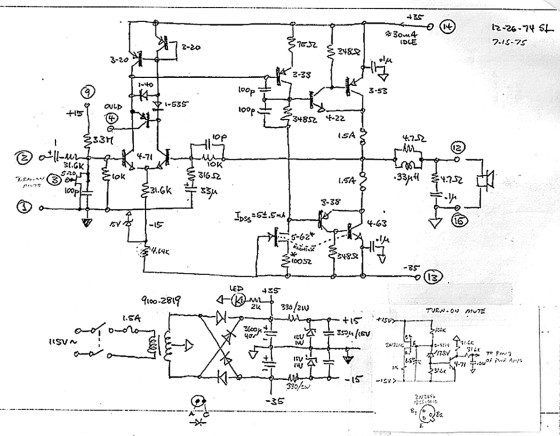
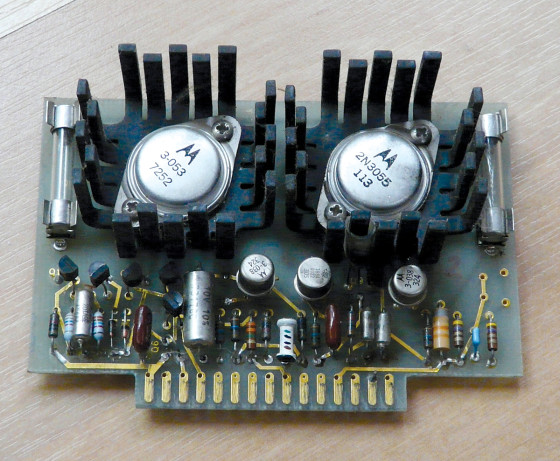
JD : Let’s talk about your Orions, because they’ve been staring at me for some time now! I would imagine that they just didn’t spring into existence but that they are the result of a long process.
SL : Yes, it was a long process of trying out and verifying ideas and increasing understanding. What I learned was that the important thing to do, starting with the crossover, was to control the polar response. I mean, there’s nothing wrong with, say, a 3rd-order Butterworth; it works fine, but unless your drivers are coincident, you will have a varying polar response.
Once I got from a boxed speaker to a dipole, I not only got rid of all the typical box issues we talked about earlier, but I also was able to greatly improve the polar response. All boxed speakers are omnidirectional at low frequencies, and start to increasingly beam at higher frequencies. The only speaker that has some low-frequency directivity is the dipole, with the possible exception of a cardioid. But the
cardioid actually is a combination of omni- and dipole.
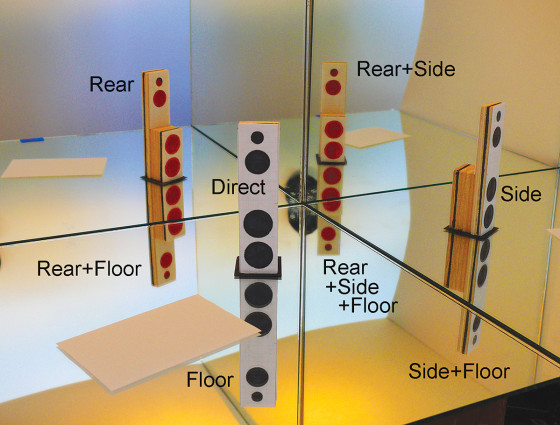
JD : The low-frequency (lf) forward polar response of the dipole comes from the destructive interference from the rear- and back wave?
SL : Yes. A dipole starts out more directional already at lf compared to the box. What that gives is a more uniform off-axis response, and that is very important in a living room setting.
And as you know, that is a very critical issue. All room boundaries can act as “mirrors” to create mirror images of the sources (Fig. 3). It’s a very involved subject, too much for an afternoon’s talk, but much of what I have found out about this aspect can be found on my website (www.linkwitzlab.com).
The typical box speaker has a power response or directivity index or whatever you want to call it that varies between low- and high frequency by some 10-15dB. Nobody does it better than 10dB. Now, at lf a dipole puts 4.8dB less power into the room—for the same on-axis response—as the box. So rightaway you start off with almost 5dB less difference between lf and hf. There is also an improvement in the transition region. The way the front- and rear waves from this 8” midrange combine initially broadens the polar response with increasing frequency!
I also show this in my Linear Audio article (Fig. 4). At lf it is a figure-eight but as frequency increases it becomes wider and wider. Then when you get higher in frequency, the speaker itself becomes so directional that there isn’t much coming around from the back anyway. Moving to the tweeters, you see that there’s a rear-facing tweeter as well (Photo 5) but the two don’t communicate in the sense that single
driver front- and rear waves may communicate. They both become directional with rising frequency, one to the front, the other to the rear and they don’t interfere, so that’s again a dipole setup.
I’ve seen some people trying to build a dipole tweeter on a very narrow baffle, but that’s very hard to do because at 10kHz the wavelengths involved are pretty short. So it’s unavoidable that you get some destructive interference, also on the front, so you need to move more air when frequency goes up, all out of the small tweeter. But if you use a real baffle like I do, for the tweeters also, the front- and rear tweeter act as an independent source for the dipole and there’s no interference to speak of.
That’s why I said: they don’t communicate! But all this required much experimentation and measuring and trying various shapes and dimensions.

JD : And lots of listening, I guess?
SL : Not initially. I generally don’t listen to a design until I’m satisfied with what I am measuring. Then I start listening to see whether there’s some issue I missed with the measurements or if there’s a possible optimization.
JD : Do you find good correlation between your measurements and what you hear?
SL : Oh, yes, very strongly. But it takes a lot of experience to know what to look for in your measurements and what it means. There’s not a single measurement I know of that gives you everything; you sort of look at the total picture that emerges with lots of measurements and I’ve learned to integrate and interpret them and that strongly correlates with the listening sessions. Also I’m not looking at small details, but I look more at trends. I’m not really interested in small ripples but I look for things like: is there an upward trend in the response from low to high, or is there a bump somewhere, and try to correct for that. Now sometimes I do look at ripples in the sense that I want to know the physical cause and if I think it is from the driver or enclosure I try to fix it. But I don’t try to equalize each and every ripple.
JD : At the Burning Amp show you had some Orion prototypes where the woofers were mounted horizontally rather than vertically. Why is that?
SL : Yes, they are prototypes I am experimenting with. In the vertical alignment, one above the other, there is a rocking force on the baffle because the cones move in the same direction.
I knew that with the horizontal mounting, one above the other, I would get rid of that. But I just started to look at it, and I don’t know if it affects the sound in general.

SL : I did at one time build a 1:10 scale model of a listening room. I wanted to study very low frequency response down to 5Hz, and with a 1:10 scale it’s the same as looking at 50Hz. Now you also need a driver that is scaled down a factor of 10 in dimension, and what I ended up using is this tweeter on the Pluto. That tweeter is flat down to 200Hz and then starts to roll off, so I equalized that. The output is not very high, of course, but I had a relatively low noise environment (the scaled down box) and ultimately my noise limit was the test equipment limit.
So I built a dipole from two of those tweeters, and it all worked exactly as theory predicted. But there was one snag: I did scale all linear dimensions but not the damping of the “room,” so I ended up with a reverberant “room.”
I did try to use lossy walls but never got it quite right. It’s the same problem acoustic architects have when they build scale models of a music hall to study the acoustics.
But anyway, I was so impressed with that little tweeter that I thought: maybe I can build a speaker without diffraction, just a point source over a large band, to see how that would sound. That became the Pluto speaker (Photos 3 and 4). Now, of course, they are quite different from the Orion in concept, yet what surprised me was the very similar “tonality” if you want, of the Pluto and the Orion. That was another important input for me to start to look more in depth into polar patterns and reflections. The differences in sound were easily correlated with polar response differences and that’s when I added the rear tweeter to the Orion.

JD : When you do your listening tests, what do you listen for? What type of music do you use?
SL : My initial listening is always done with a single speaker, in mono. If you listen in stereo you have the additional spatial information and it’s sort of distracting; it’s more forgiving about speaker shortcomings.
Mono is less forgiving. Then, I like voice sounds, but not solo because solo is often recorded with very close miking and that makes it less natural sounding. I have some choral music I am very familiar with so I use that a lot. I also listen to classical recordings because I go to classical concerts so there’s familiarity. I’m not that familiar with jazz and, of course, pop is—to a large extent—artificial.
I use classical music, large orchestras in particular, to test the dynamics of the speaker. That’s another gripe I have with many speakers: they are not designed to play at near-realistic levels.
You can’t reproduce the levels of a concert in your room, you just can’t sustain it, but you must be able to get close enough for realism and that means lots of acoustic power.
JD : So what is the limiting factor of the dynamics? Is it the speaker or the recording?
SL : Very often it is the recording. But if the recording is made from the perspective of the audience, you can get very believable dynamics. A recording with a mike at the conductor’s position and lots of other mikes at each instrument section and all mixed down to two streams may sound quite spectacular, no doubt about it, but it’s not realistic.
I will speak at the Tonmeistertagung in Leipzig later this month and I intend to address this issue that we may not hear, as listeners, what the “Tonmeister” intends us to hear. But it’s a touchy subject so I will be very careful!
I will also demonstrate my Plutos there; I heard that the recording world has all but written off omnidirectional speakers for monitoring and maybe I can convince them that that’s a bit premature.
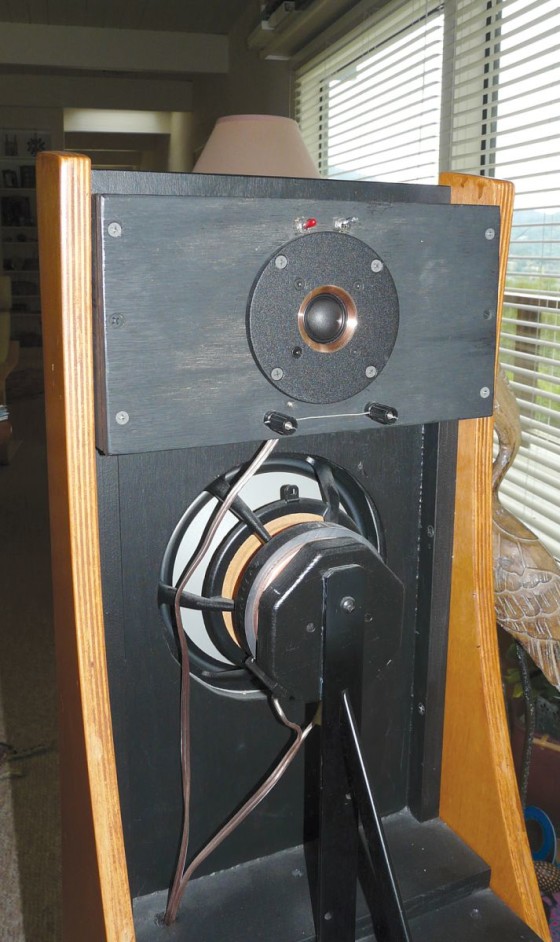
JD : Looking at your Orions, I can’t but wonder whether that purpose designed analog crossover cannot be replaced by a DSP unit?
SL : In principle, I am convinced that it can be done. But it’s not trivial. You need to measure and adjust the whole chain, analog in to sound out. Now someone may come up with an FIR filter that makes everything linear phase, but you get pre-ringing from the filter and the sound may combine correctly at one point in space but what about off-axis?
You could use IIR filters to mimic the analog filters, and that would probably be my approach. Then I would first make the amplitude response correct and then you can do an overall phase response correction of the complete system. That’s how Bruno Putzeys does it in his Grimm Audio two-way.
And I would not buy a standard DSP box off the market. The devil is in the details. But it’s hard, and it’s not on my to-do list!
JD: Siegfried, it seems to me you still have no intention to follow your own advice from 1974 and leave speaker research to others! Thank you very much for your time and for your insights.


